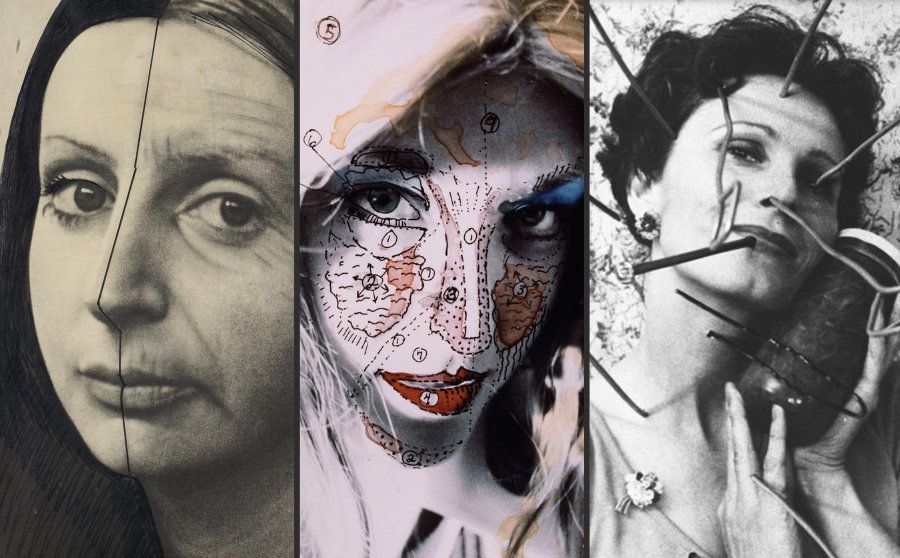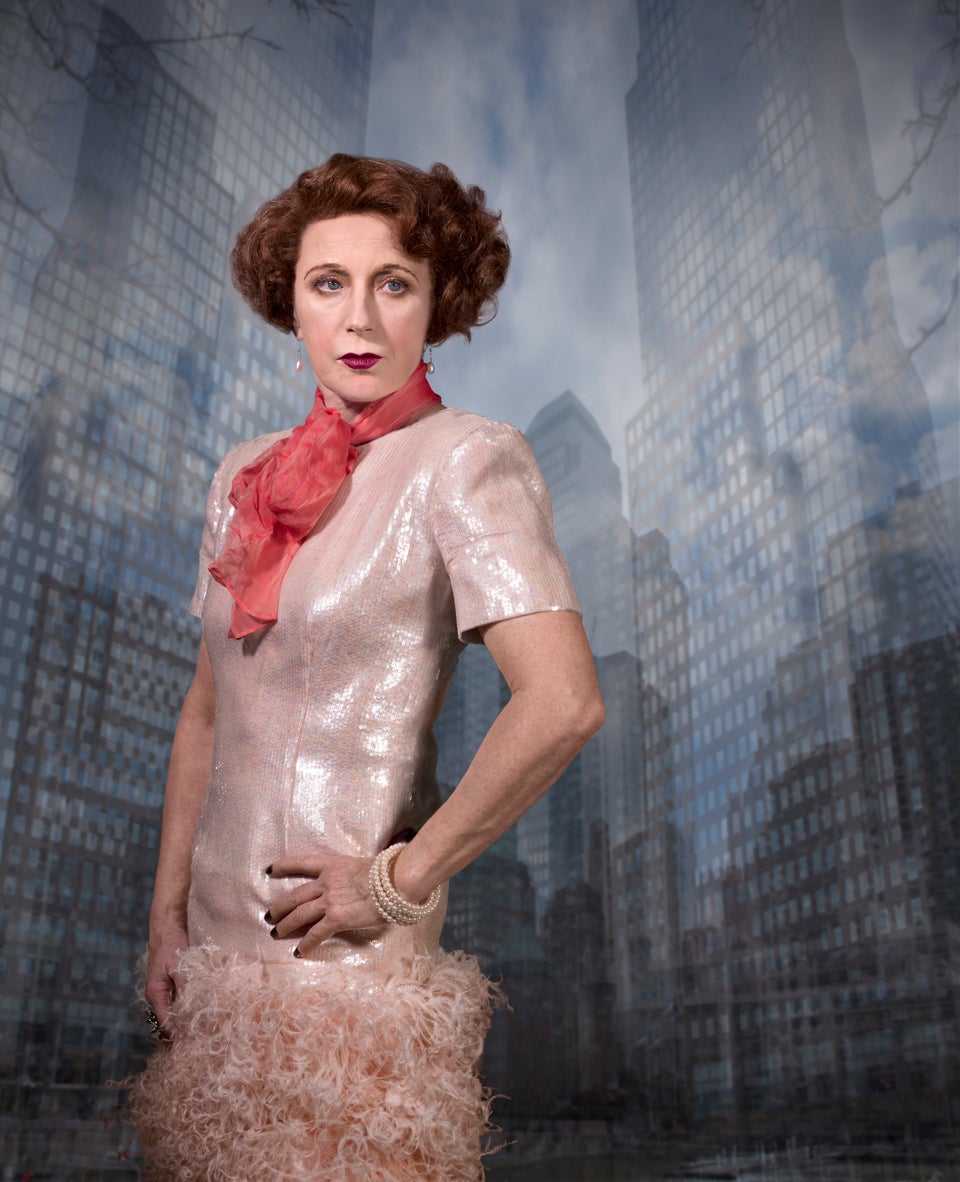In the age of the selfie, women are all too familiar with what photographs of themselves silently suggest. Who are you? Where is your natural habitat? Which circles do you run with? Are you glamorous? Natural? Spontaneous? Professional? Sexual?
There is much to critique about the contemporary relationship between women and their photographic image, whether it’s taken by themselves or by another. On the upside, though, there is a growing awareness of the constructed nature of these photos ― how they represent playful performance more than fixed truth. Rewind 40 years or so and this was not the case.
A new London exhibition titled “Feminist Avant-Garde of the 1970s” revisits a time when most women were regarded as passive muses instead of authoritative subjects and makers, in control of their bodies, identities and work. The stunning show celebrates 48 radical women artists who used their artwork to shatter the status quo, disrupt the male gaze, question assumptions of feminine identity and forever destroy the myth that art-making is a man’s game.
The exhibit is divided into four sections ― focusing on domestic space, sexual objectification, masquerade and performance of identity, and beauty norms ― and features a whopping display of over 200 artworks. Below, we delve into the stories behind eight brilliant, bold and utterly badass feminist artists who changed the rules for women in the art world forever.
1. Hannah Wilke
New York, New York (1940–1993)
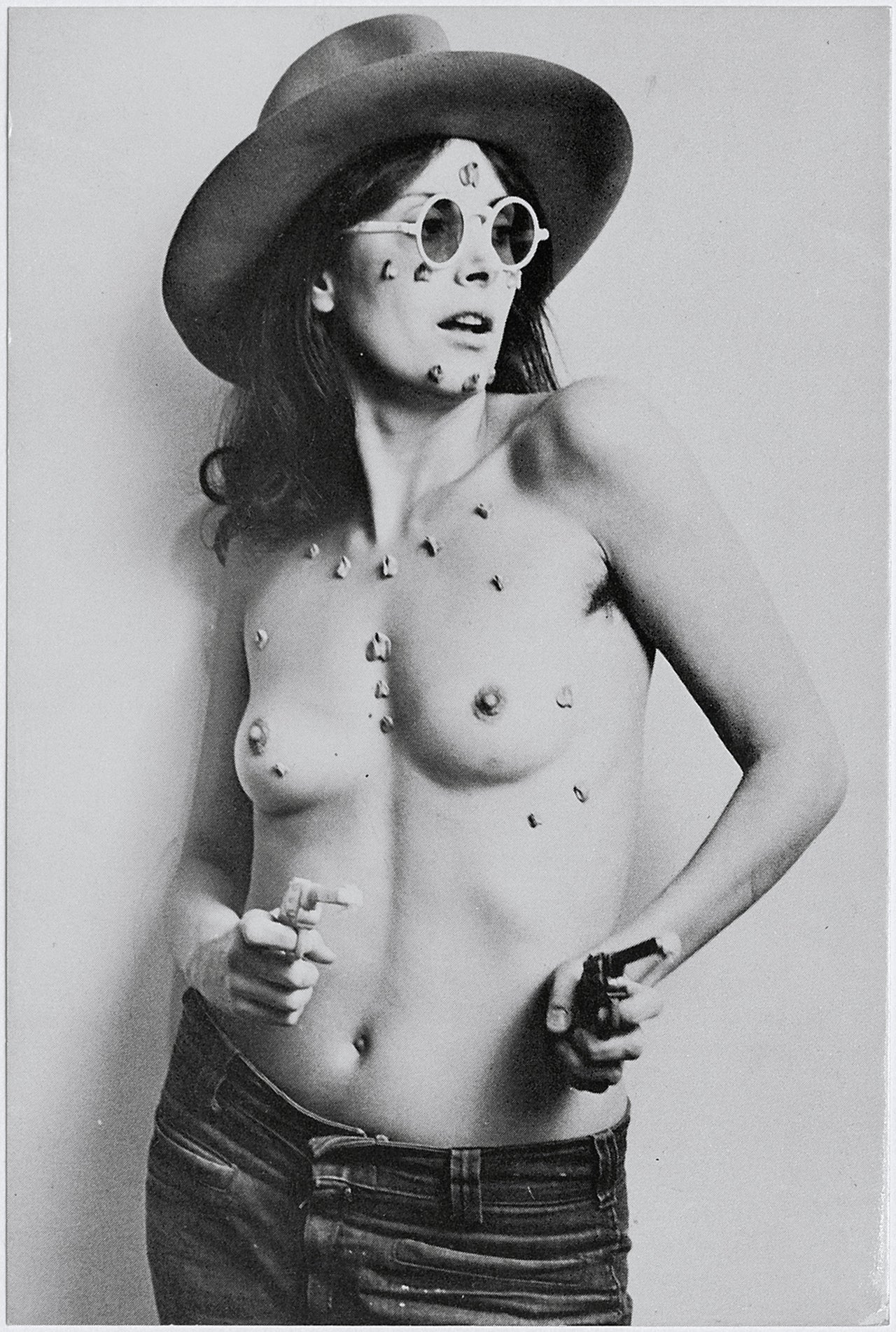
The most unfair critique conceptual photographer, performance artist and sculptor Hannah Wilke encountered throughout her life was that she was too beautiful. Because the conventionally stunning artist incorporated her own body into her work, often nude, she was constantly accused of being narcissistic and flaunting her appearance.
“People give me this bullshit of, ‘What would you have done if you weren’t so gorgeous?’” Wilke once noted. “What difference does it make? [...] Gorgeous people die as do the stereotypical ‘ugly.’ Everybody dies.” When Wilke herself was diagnosed with cancer, she documented her degenerating body in the series “Intra-Venus,” at which point many of her detractors accepted the undeniable fact that Wilke was making challenging and critical artwork all along.
Wilke is perhaps most well-known for her series “S.O.S. - Starification Object Series (1974–82),” in which she covered her body with wads of gum folded into abstract origamis reminiscent of female genitalia. Wilke then photographed herself covered in the pinkish lumps, alluding to the objectifying nature of the male gaze ― while simultaneously disrupting it.
2. Cindy Sherman
Glen Ridge, New Jersey (b. 1954)
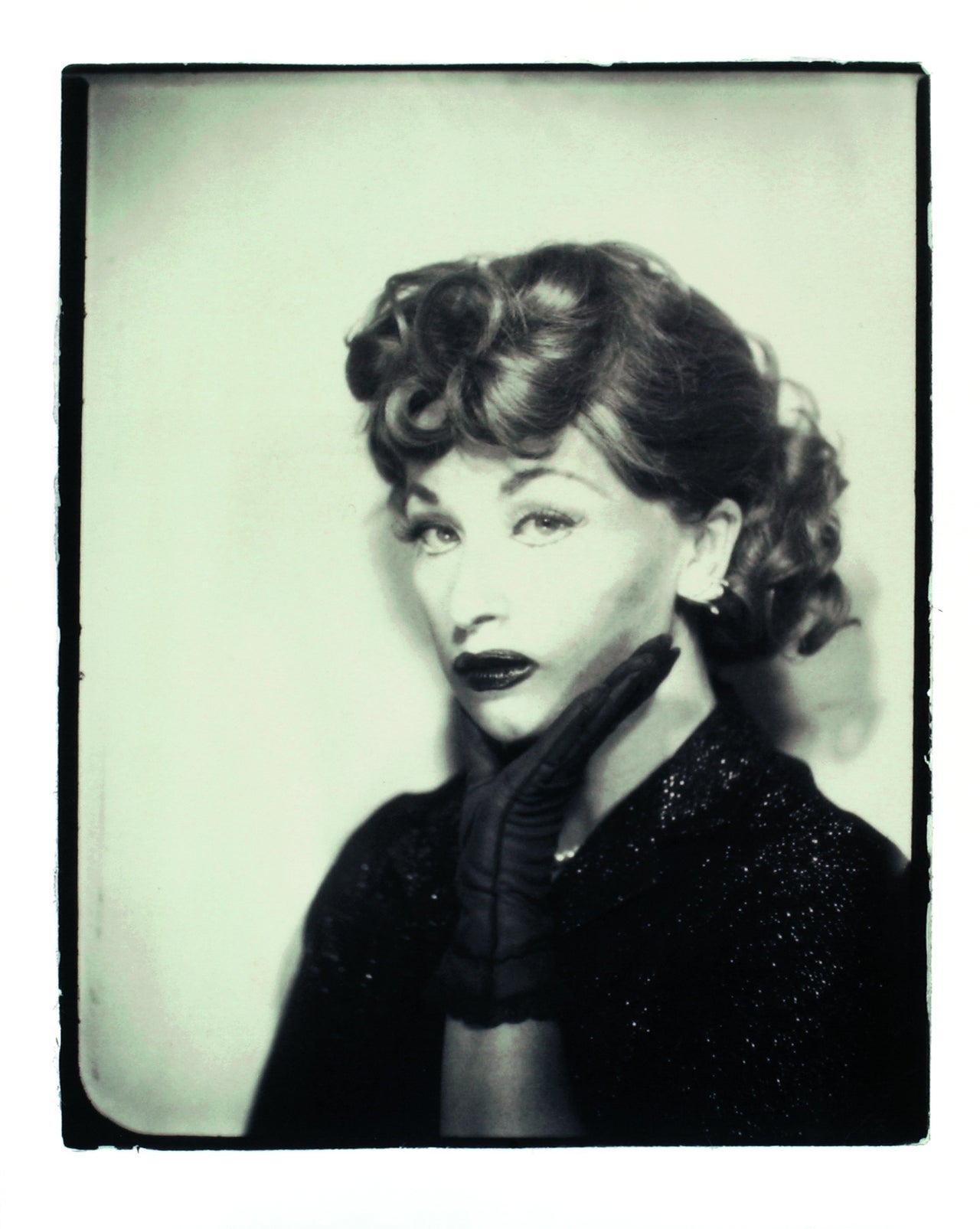
“If you don’t like me this way, how about you like me this way?” Cindy Sherman told The Guardian when discussing her predilection for playing dress up, a passion that’s remained at the core of her conceptual photography practice for over 30 years.
Using makeup, prosthetics, wigs, ornate costumes and elaborate sets, Sherman transforms herself before the camera, masquerading as a variety of female stereotypes culled from art history, advertising, cinema and TV. In one photo she’s a Hitchcock-era femme fatale; in another, a Botox-happy suburban housewife. In her roles both in front of and behind the camera, Sherman indulges and unsettles the roles women play.
“I’m not about revealing myself,” Sherman has repeatedly said of her work, despite their being, in a way, self-portraits. Instead, the photographs toy with the ways women teeter between artificiality and authenticity, oftentimes becoming actresses in their own lives. Because after years of culture and society flattening women’s existences to stereotypes and images, women themselves can follow suit.
3. Renate Eisenegger
Gelsenkirchen, Germany (b. 1949)
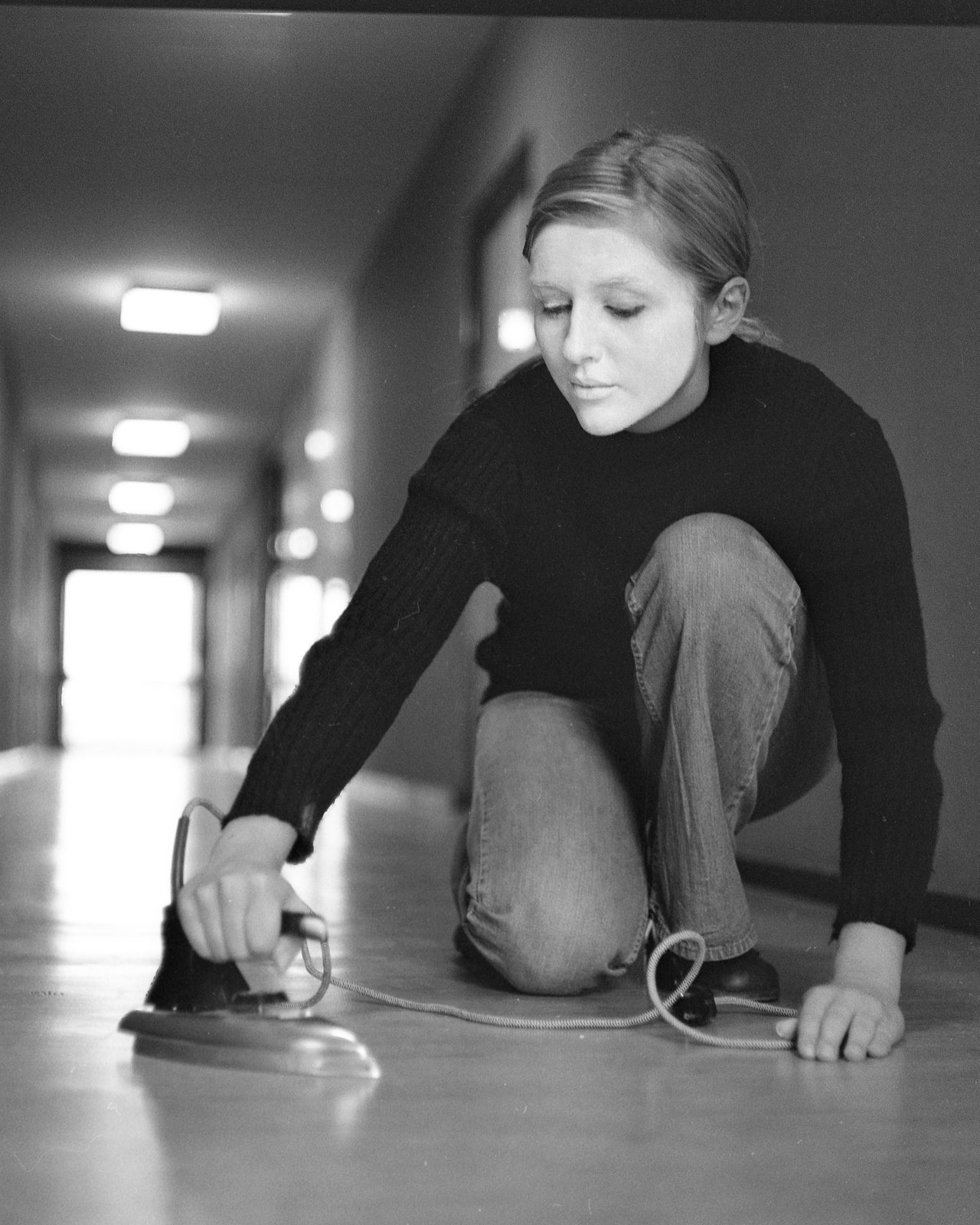
Renate Eisenegger’s most iconic gesture was painting her face, covering it first in a layer of pure white pigment, then adding black lines to create a geometric grid. In doing so, she broke from the fixed identity she had come to know, freeing her to create in new and radical ways. “In a certain way, my self seemed alien to me, as though I were shedding a previous existence,” she said of the uncanny experience.
The multidisciplinary artist was born in Gelsenkirchen in West Germany, four years after the end of World War II. As stated in the London exhibition’s catalog, when in art school, Eisenegger noticed “how women artists tended to downplay their ambitions and achievements.” She has since excelled, without apology, in her drawing, photographic, written and performance work.
In the image above, Eisenegger, in her signature white face paint, irons the floor of a high-rise building’s hallways, knowing perfectly well the floor is already quite level. The image speaks to the conformity and monotony that prevails in domestic spaces. Additionally, the ironing represents a larger kind of flattening that many women are familiar with ― a flattening of desire, dissent, and individuality.
4. Lynn Hershman Leeson
Cleveland, Ohio (b. 1941)
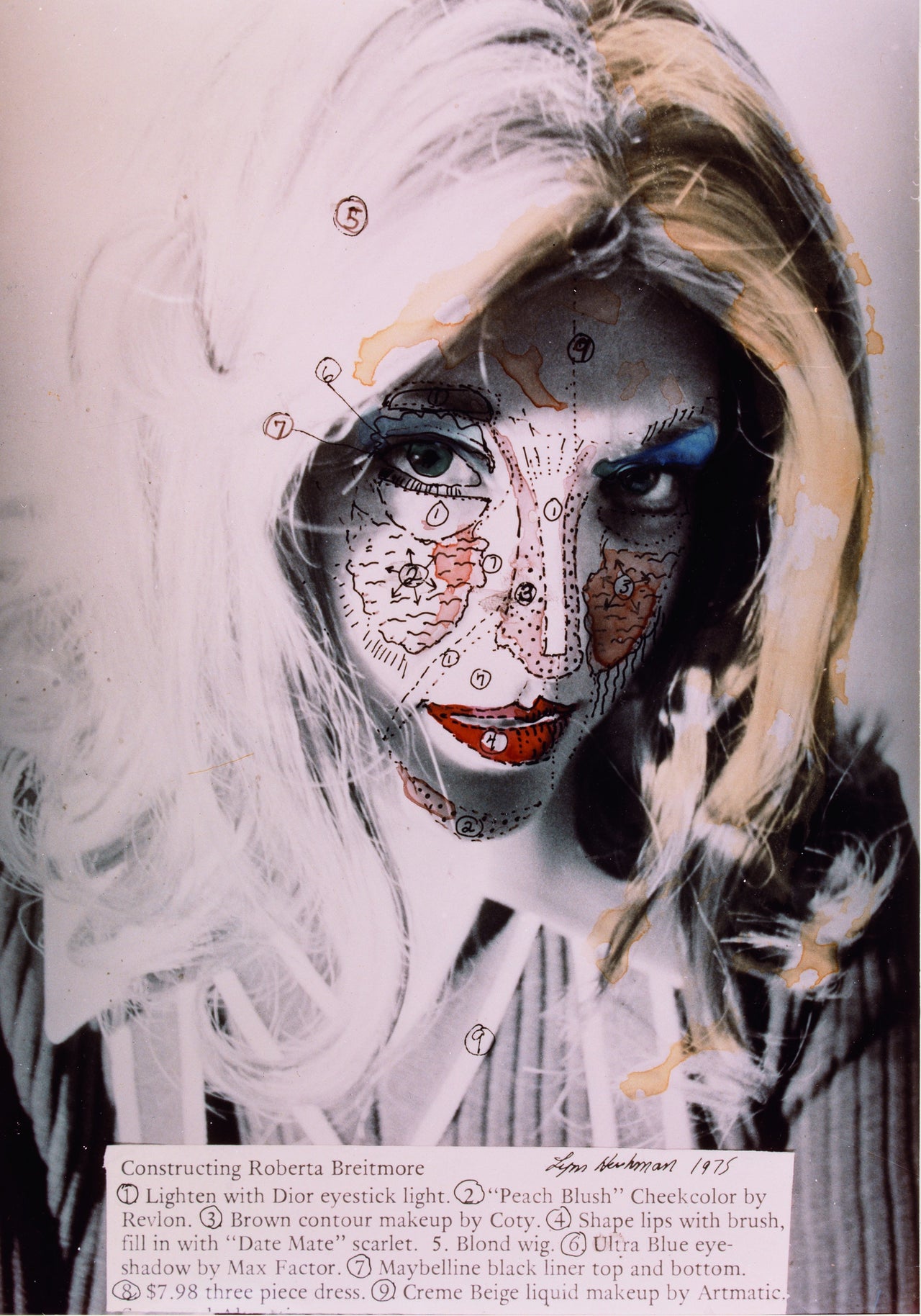
Between the years of 1974 and 1976, artist Lynn Hershman Leeson abandoned her identity and adopted another: her new name was Roberta Breitmore. Leeson accomplished this feat by donning a blonde, Marilyn Monroe-style wig, a face full of makeup, and a different, learned way of moving about the world. She also acquired a driver’s license, opened a bank account and got a credit card.
Over the course of these two years, Leeson attended art openings, dated men, visited a psychiatrist, all under the guise of being another. “If you go back to that time in the 1970s, she had more relevance and more authenticity than I did,” the artist said, as quoted in the catalog. “Through fiction you can sometimes get to a deeper truth.” Through her work, Leeson explored the constructed nature of feminine identity, molding her own hybrid being through the costumes, technologies and borrowed behaviors all women adopt.
In the image above, “Roberta Construction Chart #1,” Leeson shows viewers the transformation that she underwent to become her character. Her face becomes its own topography, illuminating the work that went into the making of her femininity and herself. Somewhere between a scientific chart and a plastic surgery sketch, the image reflects on what women go through simply to become “themselves.”
5. VALIE EXPORT
Linz, Austria (b. 1940)
![Valie Export, " Tapp und Tastkino [Tap and Touch Cinema]," 1968](https://img.huffingtonpost.com/asset/5800e1821b0000df1cef7142.jpeg?ops=scalefit_1280_noupscale)
Until the age of 14, Waltraud Lehner was educated in a Vienna convent. As she grew up, she became immersed in the film industry, got married and became a mother. It wasn’t until 1967 when she adopted the pseudonym VALIE EXPORT, both an artistic identity and a personal brand, one that simultaneously rejected the command of the men in her life and challenged the Nazi ideology of her parents’ generation. Her last name was, in part, a tribute to a brand of cigarettes.
“I did not want to have the name of my father [Lehner] any longer, nor that of my former husband Hollinger,” EXPORT explained in a BOMB interview, “My idea was to export from my ‘outside’ and also export, from that port. The cigarette package was from a design and style that I could use, but it was not the inspiration.”
EXPORT’s work in video, performance, photography, sculpture, and computer animation, often critiqued the way commercial film and the mainstream media objectified the female body. “In order to achieve a self-defined image of ourselves and thus a different view of the social function of women, we women must participate in the construction of reality via the building blocks of media-communication,” she said. “This will not happen spontaneously or without resistance, therefore we must fight!”
For the piece featured above, 1968’s “Tapp und Tastkino [Tap and Touch Cinema],” EXPORT crafted a wearable theatrical stage and wore it on the street. She then invited passersby to stick their hands inside the stage and feel, without looking, her breasts. The piece examined the underlying relationship between violence and eroticism, seeing and feeling, private and public.
6. Karin Mack
Vienna, Austria (b. 1940)
![Karin Mack, "Zerstörung einer Illusion [Demolition of an Illusion]," 1977](https://img.huffingtonpost.com/asset/5800e1af170000c316acbf4c.jpeg?ops=scalefit_1280_noupscale)
Karin Mack’s surreal and conceptual photography revolves around a single question: where does our performance of selves end and true identity begin? The inquiry is especially relevant to women who are clearly and forcefully told what qualities they should and should not present to the public.
The Austrian artist uses self-portraiture to investigate the issue of the self, a woman’s photographic image serving as the illusory perfect synthesis of harmonious parts. Many of her photographs take a dreamy detour from traditional forms of feminine representation, shattering the false promise that women are as cohesive and pleasant as their pictures would lead one to believe.
In the series “Demolition of an Illusion,” featured above, Mack literally pierces the surface of a lovely portrait, depicting Mack leaning against floral wallpaper holding a jar of homemade jam. As explained in the exhibition catalog: “The death of the image, the destruction of the photograph, is at once the end of an illusion and an act of liberation.”
7. Mary Beth Edelson
East Chicago, Ind. (b. 1933)
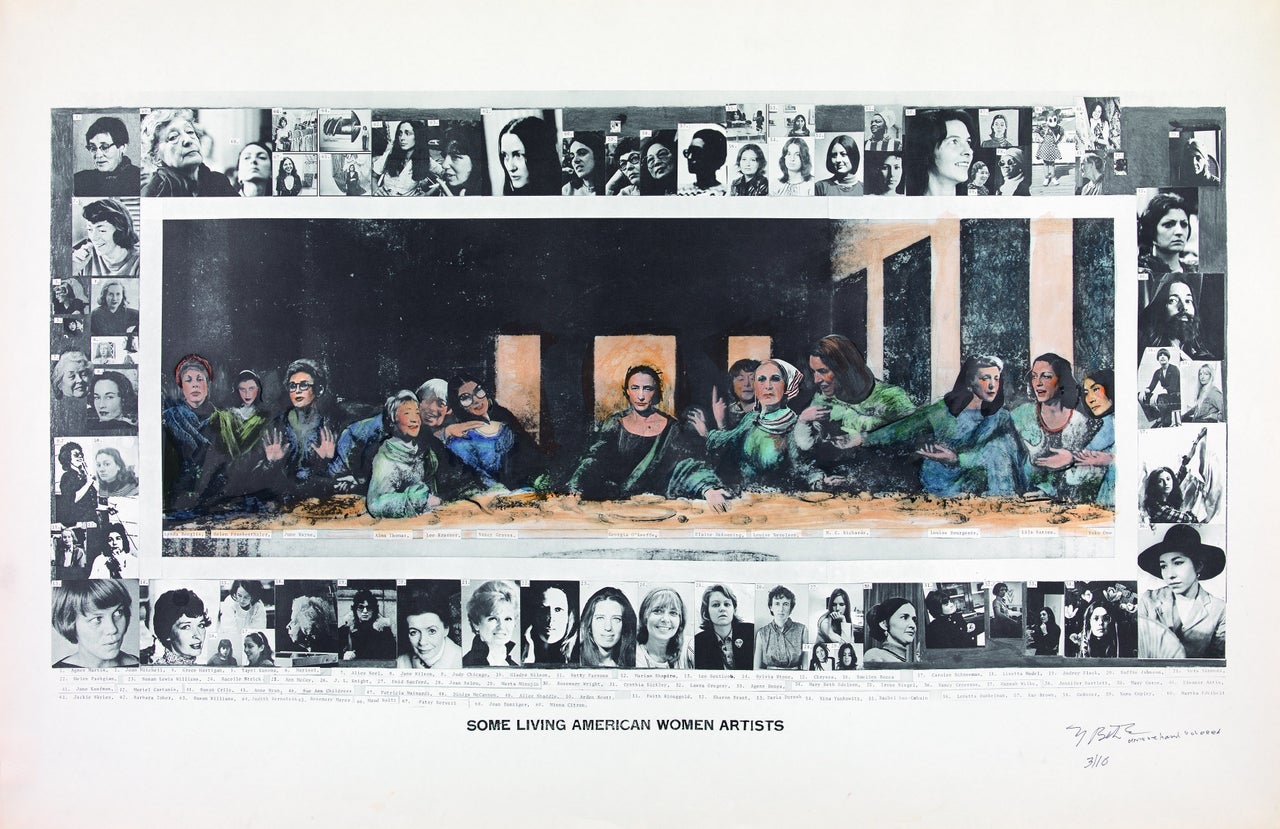
Mary Beth Edelson’s work often revisits and revamps the past, reimagining a history where femininity is privileged instead of penalized. In her “Goddess Art” series, Edelson used china marker and oil paint to transform photographs into universal symbols of ritual feminine power. The photos incorporated ancient figures like Baubo and Sheela na gig ― both of whom warded off evil by showing their genitalia.
Perhaps Edelson’s most famous work, featured above, is 1972’s “Some Living American Women Artists / Last Supper.” The artist edits Leonardo da Vinci’s iconic portrait of Christ and his disciples enjoying a family meal, replacing the men with the images of 69 female artists including Georgia O’Keeffe, Helen Frankenthaler, Lee Krasner, and Louise Bourgeois. The piece challenged religion’s tradition of oppressing women while acknowledging the feminine forces whose names and faces are too often excluded from history.
“This is what it feels like to have been edited [and] cut out of art history for centuries,” the artist said. The image was later made into a poster, which was circulated widely among women artists and feminist activists, eventually becoming one of the defining pictures of the movement.
8. Ewa Partum
Grodzisk Mazowiecki, Poland (b. 1945)
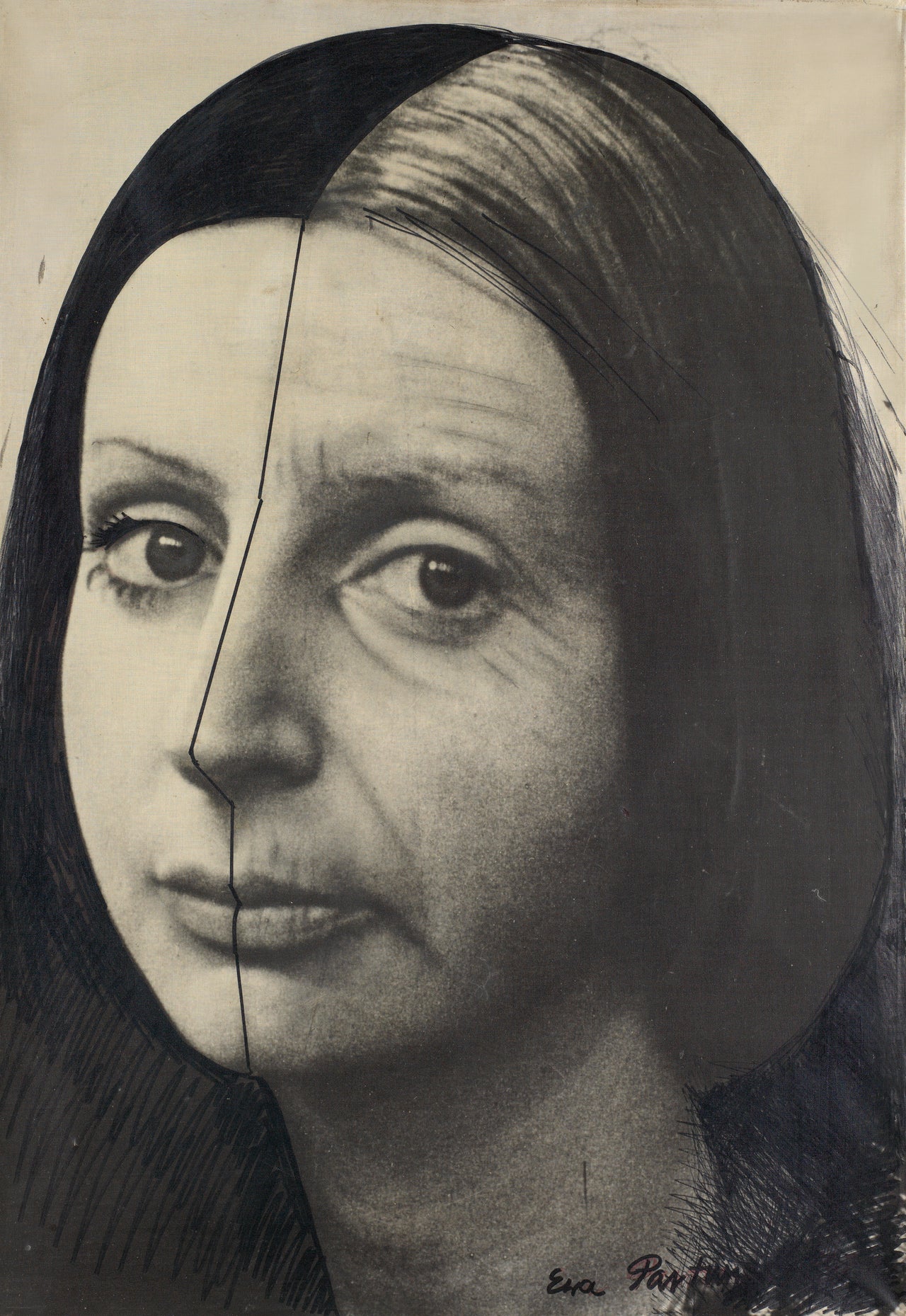
Fed up with the discrimination she felt as a woman performance artist, Ewa Partum began to incorporate her naked body into her work. Although many critics were quick to label this a maneuver of egocentrism rather than thoughtfulness, Partum expressed vehemently her desire to transform her self and body into a work of art in order to dismantle the perception that a woman’s body was a sexual object or a thing of nature. She was a signifier, a subject, in control of her body, work and life.
Partum’s work often revolved around language, poetry, women’s bodies, and the intersections between them. For her first feminist piece, 1971’s “Lipstick Pictures,” Partum took prints of her lips while mouthing particular letters, then combined the images to spell out words like “art” and “love.” The piece laid bare the physicality of language, not to mention the femininity, relishing the similarity between women’s lips and their genitalia.
In “Change,” featured above, Partum enlisted a makeup artist to, in front of an audience and on camera, apply makeup to age half of her face. By artificially aging a portion of her face, Partum addressed the standards of beauty established and perpetuated by men, that deem women undesirable as they grow older. She eventually plastered the image on posters which were spread around socialist Poland along with the words “My problem is the problem of a woman.”
“Feminist Avant-Garde of the 1970s” runs until Jan. 15, 2017 at The Photographer’s Gallery in London.
